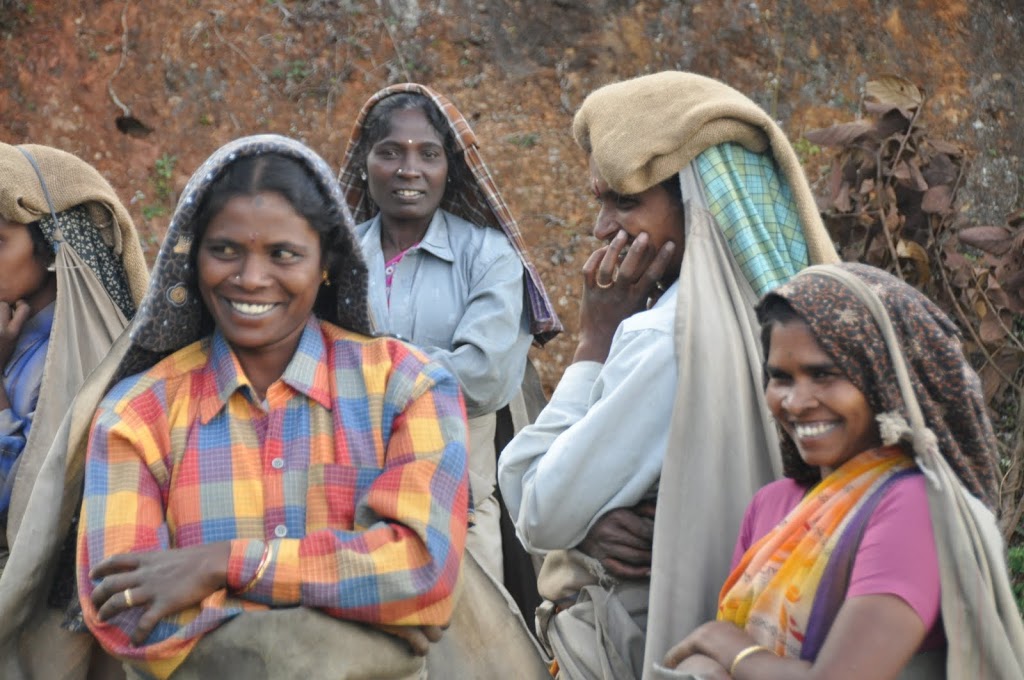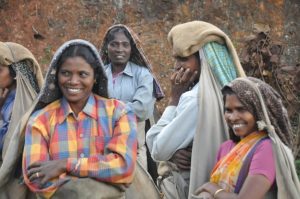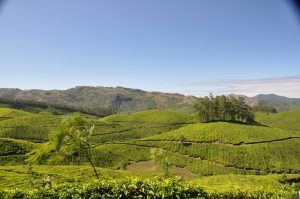
All the tea in China? Look what India is doing!!
Munnar
Lori bought me this really cool Tissot watch for our 24th anniversary. It has a touch screen that allows for additional information to be displayed. Things such as a compass, thermometer, chronometer and other neat stuff. Most of the time I use it specifically for that – time. But now and again it’s a gas to invoke the other functions. As is often the case with seaports, Kochin was at sea level. Our next destination was to the Western Ghat mountain range, specifically the village of Munnar. Munnar is situated at an altitude close to 5,000 feet. I popped the altimeter function on the Tissot and watched the readout continuously change as we entered into the mountains. I felt that it was important to advise Lori whenever the altitude shifted by 50 feet until she hit me at about 150 feet, or almost two minutes into the range. The drive took about 4 ½ hours, including a stop for yet another delicious meal. The last hour or so of the journey snaked along narrow cliffside roads measuring about a lane and one third in width. (Note: for those of you requiring medication for altitude or nerves, double the standard doses when driving to Munnar). The sharp turns and blind corners do not use convex mirrors to warn oncoming traffic the way they do along the Amalfi coast. Instead, the warning system is left in the hands of the drivers who beep their horns as they approach the curves. The system is a combination of I Spy, Jeopardy and Chicken. The first person to beep has right of way, the two vehicles come at each other face to face and at the last microsecond, the last to have honked veers out of the way of the oncoming vehicle. So, to recap – you hope to see the other guy first, you then have to be quick on the buzzer, and you then prove your machismo by swerving away after scraping only the first layer of paint or chrome from the opposing vehicle’s trunk, fender or bumper.
As we approached our destination, laid out before us in vast panoramic landscape was an abundance of low green bushes, neatly sectored off into rectangular patches measuring thirty square feet. These were tea bushes. Acres and acres, mountainsides and valleys, stretching out over the horizons and reappearing on the other sides of mountains as we miraculously survived another 90 degree turn in the road.
The tea plantations are owned by 5 major interests. The Tata family, who own most of the country (cars, cell phone communications, sugar, hotels, newspapers, real estate, food processing plants, and lots of other stuff) amongst them. The Tatas are headed up by an elder gentleman, Ratan Tata, who is the last of the family and has no children. They have been stalwarts of business and have established an empire that any maharajah would have been envious of. They also did it without paying a bribe, compromising a moral, or abusing the system. As the scion fades off into the sunset, he is seeking a proper group to assume control and management of the company upon his departure. Hopefully he and Warren Buffet are exchanging CV’s that they are receiving for I fear that both the Tata and Berkshire Hathaway kingdoms will fall into disarray once the leading personalities no longer have their hands on the tiller.
Speaking of tillers, all of the tea is tilled by hand. The leaves are picked by female labour and the process goes on year round. The work is difficult, there are minimum quotas to be met (80 kilos per day) in order to get paid their daily salary of 90 rupees ($2), with an additional rupee or two per extra kilo harvested.
The Tata family has given away 82% of its tea holdings to the farmers, who are also the beneficiaries of small plots on which to plant and grow vegetables for their personal use and sale. Housing, education, and medical treatment are part of the deal as well. Workers live on compounds and are happy to have steady work.
The amount of tea grown in India is EIGHT HUNDRED MILLION TONS PER YEAR. They export 200,000,000 and drink the rest at a rate of four cups of chai per person per day. That uses up the full annual production. It has been determined that should the thirst for tea increase to five cups per day, they will have to import the difference from China.
As I presently cruise down the Alleppey canals sitting on the upper deck of our houseboat, I am greeted by the sight of endless rice paddies extending past the horizon as I look left and right. Between the rice, tea and coconuts, a non-visitor cannot conceive of the enormous quantities of foodstuff that are being produced here. Mind you, with a billion or so mouths, the scale seems appropriate.
EAST MEETS WESTERN
Our stay at the Munnar resort – a local version of Club Med, was relatively uneventful as we visited the local nature sight, saw a bunch of rare goats and freaked out some more on the winding roads. However, in Chennai I had developed a zit-like growth on my right thigh that seemed to have an ingrown hair trapped inside. Continuous picking and prodding did nothing to improve the situation. To the contrary, by the time we hit Munnar, it was infected, swollen, red and quite nasty. Aside from contemplating the benefits of coming home with one leg (all the excess baggage charges should be offset by thirty five pounds of non-accompanying leg), I felt that in the long run, I was best off avoiding gangrene. The hotel had access to a local hospital that was on a private tea plantation. Our trusty driver Saiju, Lori and I headed off to the clinic not knowing what awaited us.
Upon entering the facility (word used loosely) we were greeted by a chalkboard indicating the daily stats of the hospital that was serving 2 plantations. The Lockhart plantation was obviously the one to work for since there were none of its staff in the hospital. The other plantation had 5 patients, 4 men, and one woman. The ‘Has Infectious Disease’ box was not checked off on the board, much to my relief. I was ushered down the corridor where a kindly old gentleman was introduced to me as the doctor. He reminded me of Doc Holiday from the old Wyatt Earp TV show in both look and demeanour. He had me sit down, raise my leg onto a stool as he did some exploratory prodding and squeezing. He and I, following our consult, were in agreement that a boil-like growth was inhabiting my thigh and would have to go. He then called for his nurse who brought forth a clamp-like instrument, sort of a dull pointless pair of scissors with the last half inch curved downward that he proceeded to jab into my open wound to a depth of about a quarter inch of sore and infected flesh. He squeezed the tongs and extracted a piece of my flesh that I hope housed the offensive hair, insect, dirt, or alien life form. I have a new appreciation for frontier doctors who remove bullets and even more so for the frontiersman whose bodies were the recipients of said bullets. I grimaced but would not yell out. All that was missing was the bullet to bite down on and and 2 splashes of whiskey – one for the wound, the other for me. Once the initial shock of the trauma wore off, the nurse began to introduce a cotton cord that had been dipped into a yellow anti-biotic into the gaping and bloody wound. I watched a little bit of the procedure but opted to avoid the heroics and looked away. I had no desire to faint from revulsion in front of the doctor, nurse and my wife. She continued to wind the cloth down and in, acting carefully and gingerly, with Lori watching on fulfilling her wifely duties beyond the normal requirements as clearly spelled out in the Kutuba. It was like watching the famous Indian cobra emerging from the basket routine in reverse. Once she completed inserting a quarter mile of the cord into my leg, a gauze bandage was applied. In my near hallucinatory state, I hearkened back to a childhood event with my friend Lonnie who had come over to my house with a cut and obsessed on gauze as the only possible cure for his condition. I was hoping beyond hope that he had been right. The cord has been in for a day and is due to be pulled out my me and/or Lori tomorrow. The infection has subsided and the only pain I’m feeling now is that which one would normally associate with the trauma of being gouged in the thigh with a blunt instrument to a depth of too many millimetres. The price of the surgery was 50 rupees, or $1.07 Canadian. Apparently it is the anaesthetic that pushes the cost of our health care up dramatically. When I return home I will send a letter to the Minister of Health. I will suggest bullets and whiskey as a practical approach to keep the spiraling cost of Medicare down. While I have not had the pleasure as yet to carefully inspect the doctor’s handiwork, in addition to the other souvenirs we have purchased on this trip, there will likely be one that I will have forever. I call it The Scar of India.
The drive home took us through a spice plantation that was also designed to attract tourists. They were all there – cinnamon, cloves, cardamom, turmeric, posh, mel, mel c, baby, and sporty, ginger, mary-ann; you name it. We had the opportunity to see how they grew, whether roots, berries, leaves or bulbs were used and how the processing was handled.
The most amazing thing to me about the world of spices is how people would actually figure out that digging up a particular root, drying it for a fixed period of time and then utilizing it in a dish would add flavour, increase the storage potential for the food, and improve a particular element of one’s health. I’m sure that there were some significant errors in the trials – to whit “Here, try my poison ivy soup”, “Just sprinkle some of this hemlock on your pancakes; it should add flavour”, or “Chew on these cloves of garlic before you take her to the movies tonight”. We purchased a few vanilla beans and will try to find the appropriate recipe upon our return.





No Comments